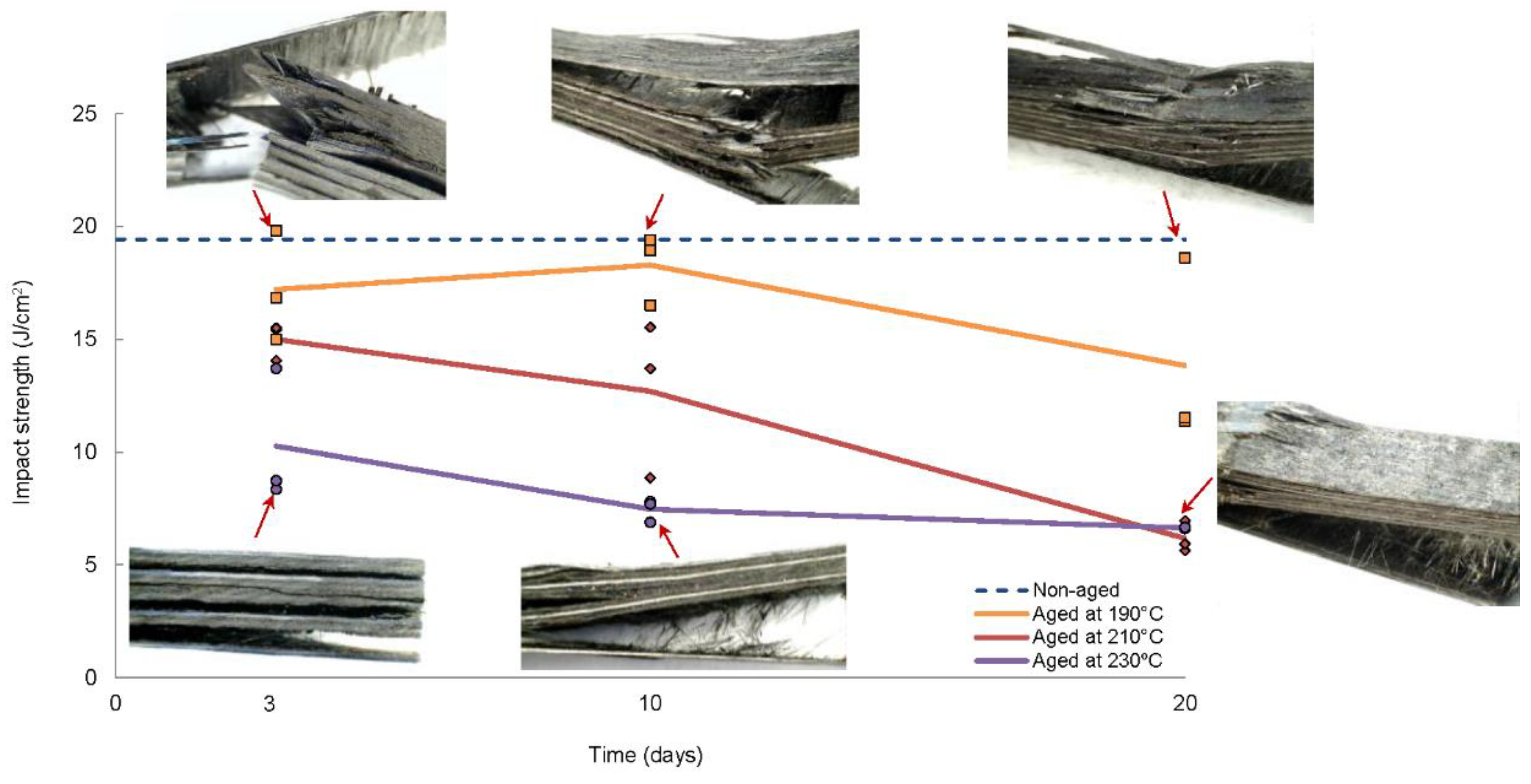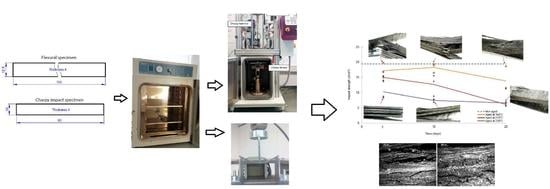The main effects of thermal ageing on the impact damage resistance and flexural behaviour are summarized in the following sections.
3.1. Effect of Thermal Ageing on the Impact Damage Performance
Charpy impact tests were performed in a drop weight column in order to study the influence of thermal ageing on the impact damage response of CFRP laminates. The effect of temperature and time of ageing are particularly studied in this section.
Firstly, some initial tests were performed in non-aged laminates with the aim of determining the impact behaviour of CFRP specimens and using the corresponding absorbed energy values as reference. For that purpose, the study of the impact response was performed in quasi-isotropic [0/90/±45]
2s and cross ply [0/90]
4s laminates. Some representative force-time, energy-time histories and force-displacement curves are depicted in
Figure 5.
Table 4 shows the maximum force and maximum absorbed energy per unit cross-sectional area (or impact strength
Ec) results of the laminates subjected to an impact energy of 32.46 J.
The results highlighted that the averaged impact strength of cross-ply specimens (23 ± 6 J/cm
2) was slightly higher than the corresponding to quasi-isotropic specimens (20 ± 1 J/cm
2) but with a greater dispersion. However, there were not significant differences in the failure modes observed for the two configurations. In both cases, fibre breakage as well as matrix cracking and delaminations were observed around the impact area (
Figure 6). The influence of the stacking sequence on the absorbed energy and impact strength was analysed in previous works [
44] and it was observed that multidirectional specimens depicted higher values of absorbed energy and the failure modes were a combination of those showed in unidirectional ones. The presence of 0° fibre layers provided enhanced impact behaviour and highest values of absorbed energy. Although quasi-isotropic [0/90/±45]
2s laminates showed pseudo-ductile behaviour [
38,
44,
45] due to the shearing effect of the 45°, the number of 0° layer was smaller compared to cross ply [0/90]
4s. These results were in agreement with previous studies in which cross-ply laminates depicted the highest energy absorption and exhibited the maximum impact resistance compared to unidirectional and quasi-isotropic composite laminates [
46]. Although cross-ply laminates depicted an improved impact performance, it was decided to study the thermal ageing effect on quasi-isotropic laminates in order to reduce the dispersion and identify with more precision the effect of thermal degradation.
The results obtained from the impact tests of aged laminates at 150 °C for long periods of time are shown in
Figure 7. This temperature was below the glass transition temperature (195 °C) and the carbon-epoxy composite laminate was supposed to maintain the mechanical properties, as the manufacturer indicates. For that purpose, ageing treatments at 150 °C for 28, 35 and 42 days followed by impact tests were performed on quasi-isotropic laminates. The average maximum force and impact strength for the different time of ageing were summarized in
Table 5. The failure modes observed were a combination of fibre breakage and delamination (
Figure 7). The average values of impact strength were plotted in order to observe a possible trend in the impact performance. No degradation was noticed in the impact performance of quasi-isotropic specimens regardless the time of exposure at 150 °C, as can be deduced from the close values of absorbed energy for the different periods of ageing. On the contrary, a slight improvement in the impact strength with respect to the non-aged specimens (19.62 J/cm
2) occurred, particularly for the specimens aged at 150 °C for 35 days (22.06 J/cm
2) in which the increase in impact strength was about 12.5%. The same behaviour was observed in previous studies, where they observed that before the degradation of the mechanical properties of carbon fibre-reinforced composites, a consolidation phase occurred related to a post-curing process [
20,
47]. The exposure to temperatures below the glass transition temperature ensured better adhesion between the matrix and the fibres and improved the impact response of this material.
Finally, additional ageing treatments were performed at temperatures very close and above the glass transition temperature (
Tg = 195 °C) in order to accelerate the degradation and detect a possible dependence of the mechanical properties of the CFRP laminates with the temperature and the exposure time. For that purpose, ageing treatments at 190 °C, 210 °C and 230 °C were performed on quasi-isotropic [0/90/±45]
2s laminates. The time of ageing considered for this study were: 3, 10 and 20 days. The values of the average maximum force and impact strength for the different ageing treatments are shown in
Figure 8 and
Table 6. The results revealed that both temperature and time of ageing affected significantly the impact response of CFRP laminates. On one hand, it was observed that the highest values of impact strength corresponded to the ageing treatment at 190 °C and as the ageing temperature increased, the impact strength decreased. On the other hand, comparing the energy that was absorbed at a particular temperature, it can be concluded that longer exposure time to high temperatures resulted in further degradation. A slight improvement on the average impact strength was observed after 10 days of ageing at 190 °C, however it did not seem to be associated with a post-curing process because, in that case, the improvement should have appeared from the beginning and overcame the value for the non-aged laminates. A possible explanation for this apparent increase could be the dispersion of the results as a consequence of the manufacturing technique (hand lay-up), that frequently causes the presence of discontinuities in the laminates. The same explanation would explain the higher values of absorbed energy of the laminates aged at 230° than those at 210 °C after 20 days of ageing.
As shown in
Figure 8, one of the most remarkable effects of ageing was the change in the failure mode. In specimens aged at 190 °C (close to
Tg) for short periods of time, the main failure mode were fibre breakage and delamination, the same as non-aged specimens. However, as temperature and time of ageing increased, the polymeric matrix experienced a significant degradation, decreasing the adhesion between the matrix and the fibres. Thus, failure occurred mainly through the matrix resulting in lower energetic failure mode.
It is important to note that ageing treatments at temperatures very close and above the glass transition temperature caused remarkable degradation in the impact resistance of CFRP laminates, even for short periods of time (3 days), as it is shown in
Figure 9. This behaviour contrasts with the observed at 150 °C as it was discussed previously.
3.2. Effect of Ageing on the Flexural Performance
A series of three-point bending tests were performed in thermal aged quasi-isotropic [0/90/±45]2s laminates in order to determine the effect of temperature on the flexural properties of CFRP laminates.
The effect of ageing on the flexural resistance was evaluated by means of average maximum flexural stress, flexural modulus and flexural strain (
Table 7). Additionally, optical micrographs of the cross-sections of the samples were examined to gain an insight into the assessment of different failure mechanisms. Three-point bending tests were conducted at room temperature.
Figure 10 shows flexural stress-strain curves for the different [0/90/±45]
2s quasi-isotropic laminates aged at different temperatures for 10 days. Temperatures below and above the glass transition temperature were considered. The curve corresponding to non-aged quasi-isotropic laminate was also included for comparative purposes. The maximum flexural stress gradually decreased as temperature of ageing increased, as it was expected, except for specimens aged at 150 °C, which depicted the highest value of flexural stress, 15% higher than non-aged specimens. Thus, the post-curing effect was also observed on flexural samples, similarly to impact samples. The decrease of the flexural properties of aged CFRP laminates could be mainly attributed to changes of the molecular configuration accompanied by a hydrothermal deterioration. The maximum flexural stress was reduced significantly, with a decrease of 73% compared to its original value, after 10 days at 250 °C. The reason was the degradation of the polymer matrix as a consequence of the thermo-oxidative environment. In addition, it should be noticed that in the case of the flexural stiffness, it did not exhibit the post-curing effect as observed in the maximum flexural stress at 150 °C. On the contrary, the flexural modulus of aged specimens was considerably lower than the non-aged ones but no significant variations with the ageing temperature were observed. The maximum decrease of flexural modulus was around 57% for specimens aged at 250 °C for 10 days. Furthermore, it was observed an increase of flexural strain with temperature until reaching the maximum value at temperatures very close to the
Tg. The reason was the loss of flexural stiffness with the increase of the thermal ageing temperatures. After the glass transition temperature, the flexural strain decreased, due to an embrittlement of the epoxy resin. These results were in agreement with previously works [
7,
8,
18,
19].
Figure 11 shows optical micrographs of the cross-sections of the flexural failed samples (non-aged, aged at 190 °C and aged at 250 °C) in order to gain an insight into the assessment of different failure as a consequence of the thermal ageing. Non-aged specimens showed damage initiation at the compressive side of the specimen and delamination and fibre/matrix interfacial debonding were observed in the upper layers, close to the applied load, according to typical flexural failure of quasi-isotropic laminates [
39]. The decrease in the flexural strength of aged specimens might be attributed to the development of microcracks due to the oxidation and degradation of the matrix and the fibre/matrix interface. Micrographs verified such behaviour, where crack density and delamination significantly increased as ageing temperature increased. Further thermal degradation was observed in specimens aged at 250 °C because of an increase of matrix cracking and delamination.
Finally, Dynamic Mechanical Analysis (DMA) technique according to ASTM D7028 [
48] standard with a cantilever beam configuration have been carried out in a Metller Toledo equipment (
Figure 12) in order to obtain the glass transition temperatures (
Tg) of the flexural samples with different aging treatments. ASTM D7028 recommends the use of either a cantilever beam or three-point bending flexural loading for
Tg determination of polymer matrix composites. DMA method applied an oscillating force to the samples and measured the resulting displacement as the test temperature was slowly increased. From the measured force and displacement, the specimen stiffness was determined and used to identify the glass transition temperature (
Tg). The results of the different glass transition temperatures for the flexural samples with different aging treatments are depicted in the
Table 8. Three samples of each type were analysed and the average value was used as the final result.
The results showed a slight drop of
Tg for aged samples below the initial
Tg (150 °C and 190 °C). However, the reduction of
Tg was more significant for aged samples over the initial
Tg (230 °C and 250 °C). These downward trends are in agreement with those depicted in the impact and flexural performances of aged CFRP samples. The results are in accordance with previous works [
7,
8,
18,
20].



















